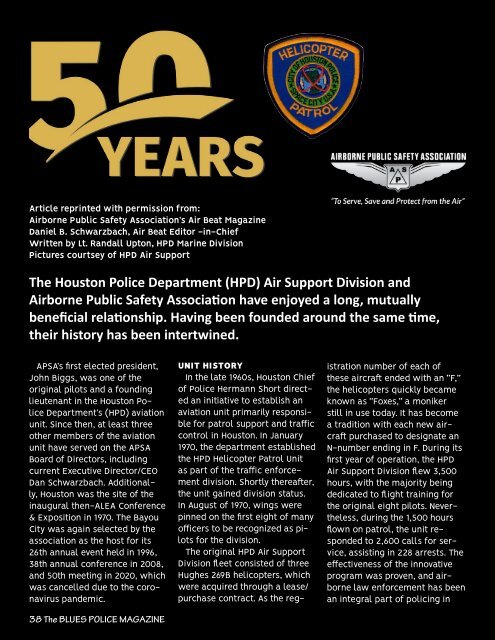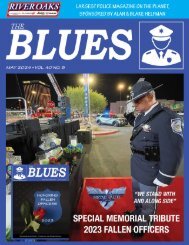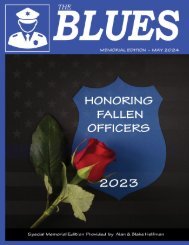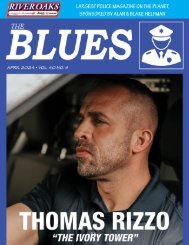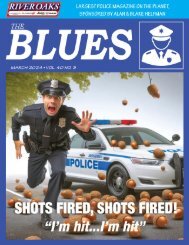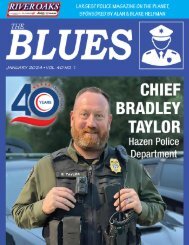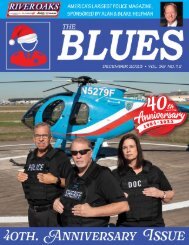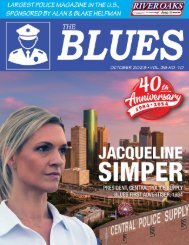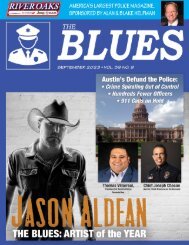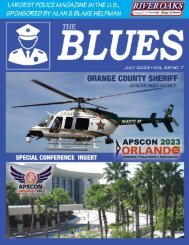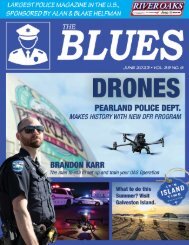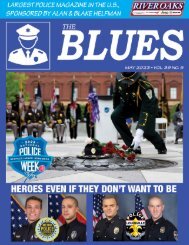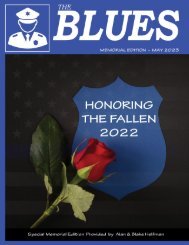SEPT 2020 Blues Vol 36 No 9
SEPT 2020 Blues Vol 36 No 9
SEPT 2020 Blues Vol 36 No 9
You also want an ePaper? Increase the reach of your titles
YUMPU automatically turns print PDFs into web optimized ePapers that Google loves.
E<br />
Reprinted from Bobit Business Media and POLICE Magazine<br />
Article reprinted with permission from:<br />
Airborne Public Safety Association’s Air Beat Magazine<br />
Daniel B. Schwarzbach, Air Beat Editor -in-Chief<br />
Written by Lt. Randall Upton, HPD Marine Division<br />
Pictures courtsey of HPD Air Support<br />
The Houston Police Department (HPD) Air Support Division and<br />
Airborne Public Safety Association have enjoyed a long, mutually<br />
beneficial relationship. Having been founded around the same time,<br />
their history has been intertwined.<br />
APSA’s first elected president,<br />
John Biggs, was one of the<br />
original pilots and a founding<br />
lieutenant in the Houston Police<br />
Department’s (HPD) aviation<br />
unit. Since then, at least three<br />
other members of the aviation<br />
unit have served on the APSA<br />
Board of Directors, including<br />
current Executive Director/CEO<br />
Dan Schwarzbach. Additionally,<br />
Houston was the site of the<br />
inaugural then-ALEA Conference<br />
& Exposition in 1970. The Bayou<br />
City was again selected by the<br />
association as the host for its<br />
26th annual event held in 1996,<br />
38th annual conference in 2008,<br />
and 50th meeting in <strong>2020</strong>, which<br />
was cancelled due to the coronavirus<br />
pandemic.<br />
UNIT HISTORY<br />
In the late 1960s, Houston Chief<br />
of Police Hermann Short directed<br />
an initiative to establish an<br />
aviation unit primarily responsible<br />
for patrol support and traffic<br />
control in Houston. In January<br />
1970, the department established<br />
the HPD Helicopter Patrol Unit<br />
as part of the traffic enforcement<br />
division. Shortly thereafter,<br />
the unit gained division status.<br />
In August of 1970, wings were<br />
pinned on the first eight of many<br />
officers to be recognized as pilots<br />
for the division.<br />
The original HPD Air Support<br />
Division fleet consisted of three<br />
Hughes 269B helicopters, which<br />
were acquired through a lease/<br />
purchase contract. As the registration<br />
number of each of<br />
these aircraft ended with an “F,”<br />
the helicopters quickly became<br />
known as “Foxes,” a moniker<br />
still in use today. It has become<br />
a tradition with each new aircraft<br />
purchased to designate an<br />
N-number ending in F. During its<br />
first year of operation, the HPD<br />
Air Support Division flew 3,500<br />
hours, with the majority being<br />
dedicated to flight training for<br />
the original eight pilots. Nevertheless,<br />
during the 1,500 hours<br />
flown on patrol, the unit responded<br />
to 2,600 calls for service,<br />
assisting in 228 arrests. The<br />
effectiveness of the innovative<br />
program was proven, and airborne<br />
law enforcement has been<br />
an integral part of policing in<br />
Houston ever since. “We need a<br />
Fox” and “Thanks Fox” are heard<br />
multiple times on a daily basis<br />
over the patrol radio channels.<br />
The 1970s and 1980s in Houston<br />
were a time of expansion<br />
through annexation and explosive<br />
population growth. More<br />
aircraft were acquired to keep<br />
up with the demand for airborne<br />
police services. The HPD Helicopter<br />
Patrol Division received<br />
its first turbine helicopters in<br />
1976, with the purchase of five<br />
Hughes <strong>36</strong>9Cs. The faster turbine-powered<br />
aircraft were just<br />
what the rapidly expanding city<br />
needed to maintain the level of<br />
service the officers and citizens<br />
had come to expect. The 269Bs<br />
were phased out for 269Cs, and<br />
within a decade of the unit’s<br />
founding, 13 aircraft were online<br />
with a 24-hour flight schedule.<br />
As demand for service and<br />
the growth of the city increased,<br />
unit manpower peaked with a<br />
38 The BLUES POLICE MAGAZINE The BLUES POLICE MAGAZINE 39


